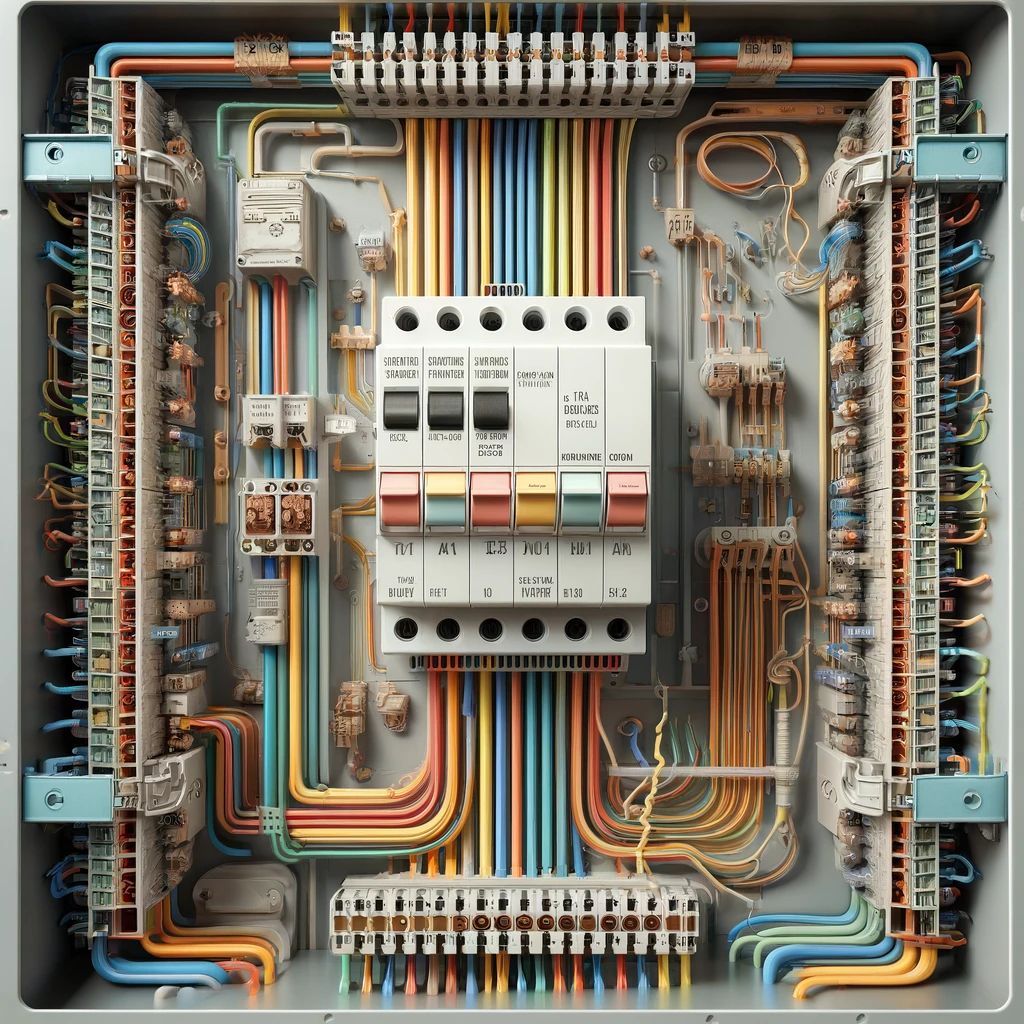Understanding the Hot Leg in Construction
The term ‘hot leg’ often leaves many scratching their heads. But fear not, it simply refers to the high-voltage leg in a 3-phase electrical system.
The reason we quickly encounter this concept, especially within the construction sector, is its role in providing power. This leg carries an increased voltage, raising the supply potential to equipment on-site.
Linking complex electrical schematics to everyday operations, understanding a ‘hot leg’ equips you to better grapple with site equipment power needs. Keep in mind – safer practices stem from deeper knowledge.

Table of Contents
What Is a ‘Leg’ in an Electrical Panel?
In the realm of electrical construction, understanding terminology is critical to both safety and efficiency. One term that often surfaces is a ‘leg’. Let’s explore what a leg represents in an electrical panel.
Definition of a Leg in an Electrical Panel
A leg, within the context of an electrical panel, refers to the point in a circuit or panel where power is supplied. In residential electrical systems, there are typically two ‘legs’ coming from the service panel that deliver 120 volts each. These two legs can also work in unison to supply 240 volts for larger appliances like electric ovens or clothes dryers.
The Role of a Leg in Power Distribution
Each leg in the electrical panel has a distinct yet cohesive role in power distribution throughout a home or structure.
- 120-volt circuits: Using power from one leg and neutral, these circuits provide power for general lighting and standard outlets. Common devices on these circuits include lamps, televisions, and small appliances.
- 240-volt circuits: Pooling power from both legs, these circuits deliver sufficient energy to power heavy-duty appliances. Washers, dryers, and HVAC systems typically fall into this category.
The Importance of Balanced Legs
The power distribution across the two legs should ideally be balanced. An imbalance can lead to undesirable voltage drops and potentially damage sensitive electronics. A professional electrician can evaluate and improve balance in the panel.
Signs of Imbalanced Legs
The symptoms of imbalanced legs can include:
- Fluctuating light intensity in light fixtures
- Unusual humming, buzzing, or flickering in some electronic devices
- Consistent breaker trips
- Unexpected wearing on one side of the panel
While “a leg in an electrical panel” may seem a confusing term at first, it’s simply a descriptive term for power distribution points within the panel.
A competent understanding of these features can help anyone involved in the construction or electrical field navigate their work more effectively, ensuring both safety and efficiency on the job.
Remember, when in doubt, always consult a licensed electrician for anything beyond basic knowledge. Electricity is not something to experiment with; it always demands respect and careful handling.

Let’s Chat About Wild-Leg Voltage
Moving beyond the fundamental understanding of what a leg in an electrical panel represents, there is a subset in this concept known as ‘wild-leg voltage’. This advanced electrical concept is used in unique scenarios, often involving three-phase delta electrical services.
Defining Wild-Leg Voltage
In the three-phase electrical system, one of the phases – typically the third one – can sometimes have a different voltage than the standard phase-to-neutral voltage. This is called a ‘wild leg’ or ‘high leg’. This distinct leg’s voltage is substantially higher, hence the term ‘wild’.
Why Does Wild-Leg Exist?
The primary necessity behind the existence of the wild leg is the demand for two types of voltage within the same electrical system. While the standard voltage serves regular lighting and power needs, the wild-leg offers a higher voltage for specific heavy-duty appliances or machinery.
Implications of Wild-Leg Voltage
The presence of a wild leg presents implications that need to be properly understood and managed for safe and efficient system functioning.
Detection and Identification
It’s essential to mark the wild leg distinctly within the electrical panel due to its high voltage, usually with orange color. It helps electricians and anyone working with the system to be aware of the wild leg, preventing accidental connections that could result in overloaded circuits or equipment damage.
Management and Distribution
While distributing the loads in a three-phase panel, it is imperative to ensure that the wild leg is not connected to single-phase loads. As the wild leg carries a higher voltage, it should only be utilized for three-phase machines designed to intake that high voltage.
The Complexities of Wild-Leg Voltage
Understanding wild-leg voltage is not as straightforward as comprehending regular leg voltage. It involves knowledge of three-phase systems and their operation nuances. Therefore, it’s one of those concepts best left to professional electricians. The layers of complexity with handling a wild leg can lead to serious consequences if mismanaged.
Wrapping Up
In conclusion, the wild leg is a unique manifestation of leg voltage found in three-phase electrical systems. It is crucial for those interfacing with such systems to recognize and manage the wild leg appropriately. This concept amplifies the fact that electricity is a field replete with complexities, requiring careful attention to detail and a keen understanding of the involved variables.
For any deeper inquiries or service requirements, it’s highly recommended to reach out to professional electricians – a step that ensures both safety and accuracy in dealing with intricate electrical concepts.

Introducing the Concept of a Ghost Leg in Electrical Work
The electrical world is full of complex terminology. We’ve covered much about ‘legs’ in an electrical panel, now let’s unravel another layer of this jargon: ‘ghost leg’ – a term that might sound eerie but is essentially another way to understand how electrical connections work.
Explaining a Ghost Leg in Electrical
A ghost leg, also known as a switch leg or traveler leg, is a wire that runs from a device (like a switch) to an equipment’s control point (usually an outlet or another switch). A ghost leg is called such because it doesn’t carry a constant load flow – it’s inactive unless the switch is turned on.
Structural Role of a Ghost Leg
Usually found in wiring systems for light fixtures and similar installations, the ghost leg’s primary purpose is to control the flow of the current. When the switch is activated (turned on), the electrical flow travels across the ghost leg to power the device. Subsequently, when the switch is deactivated (turned off), the flow of electricity is halted.
The Significance of a Ghost Leg
Understanding the workings and role of a ghost leg is crucial for any effective electrical installation and maintenance tasks that involve switches and control points. This understanding equips an individual to successfully and safely navigate any frameworks involving these systems.
Safety Factors
Recognizing a ghost leg’s functionality can prevent potential electrical mishaps. Since a ghost leg only carries a current when the switch is on, a misinterpretation of a ‘dead’ wire during a switch-off could lead to serious safety hazards when power is restored.
Diagnostic Troubleshooting
A solid grasp of ghost leg logistics can aid in troubleshooting wiring problems. For example, if a light fixture falters, knowing how the ghost leg functions can guide an ordered process of elimination to identify potential faults between the switch and the fixture.
Bringing It All Together
The essence of a ghost leg comprehends another level of electrical systems’ dynamics, enriching your understanding of the abstract concepts involving ‘legs’ in electrical work. It reiterates the significance of awareness, knowledge, and safety precautions when dealing with electrical systems in any capacity.
All instances of dealing with any electrical components should be handled by a certified professional. While knowledge is power, respect for electricity’s inherent properties and potential risks cannot be overstated.

Laying It All Out There With Legs
In conclusion, understanding the role and function of a ‘leg’ in an electrical panel equips us with essential knowledge that greatly improves our safety and efficiency when dealing with such systems.
To recap, a ‘leg’ refers to the power supply points in the service panel, each delivering 120 volts or working together for a 240 volts supply.
A prime factor to always keep in mind is the importance of maintaining a balanced load between the two ‘legs’. An imbalance can cause voltage fluctuations damaging sensitive electronics.
Moreover, routine surveillance for signs of imbalanced legs, like fluctuating light intensity and breaker trips, can prevent potential electrical issues.
From our perspective, it’s crucial to contact a licensed electrician upon spotting issues beyond our basic understanding. We’ve found that respecting electricity and handling it with care significantly reduces the risk of electrical hazards.






